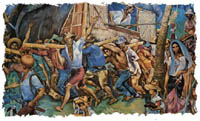Partnership with regional, provincial or local organizations or agencies is the key to decentralization
and true democratization.
To start a partnership, it is necessary to encourage counterparting. Nothing is free in the world, according
to economists; somebody always has to foot the bill or part of it.
There was a time when out of na´ve magnanimity, we gave workshops for free. We would be disappointed with
participants who would be absent for days. They had nothing to lose being absent.
Shared responsibilities between partners stabilize the relationship. It is important to spell out who is
in charge of the venues, participants, resource persons, audience, accommodation, publicity, marketing, documentation, certificates,
registration fees, etc. Essential details have to be stated in a memorandum of agreement (MOA) or letter-agreement (LA) to
be signed by the parties involved.
For the “Batang-Sining” and “Tanghal-Tula” workshops, the CCP Literature Division
always takes care of the honoraria of resource persons, readings and kits, transportation of the resource persons and CCP
staff to the site, national publicity, documentation and certificates of attendance and appreciation. The regional partner
takes charge of the participants, venues, accommodation of the resource persons and CCP staff, food, in-land transportation,
local publicity and marketing, if necessary, and audience for the showcase.
To avoid CCP or Manila “colonialism”, a fruitful cultural sharing and exchange is effected through
the formation of a team of resource persons composed of people from Metro Manila/CCP and the region/province which is the
site of the activity. The resource person for writing may come from the region considering that expertise in the language,
folklore and history of the locality is necessary. In such a case, the resource person for the performance component may come
from CCP/Metro Manila. However, there are cases when the region is strong in the performance component due to the existence
of theater groups and dramatic traditions in the area; the region may take care of the performance aspect. There are also
cases when not a single resource person comes from Metro Manila because one resource person for a workshop in Mindanao comes
from the Visayas considering his/her expertise in the language and the literary tradition in that language, e.g. Cebuano,
which is the language of the locality in Mindanao. The point is, the activity/project has to serve as an occasion for cultural
enrichment between regions, without anyone taking a position of privilege, i.e. in no case should the Metro Manila/CCP resource
person be the “educator” and the region-based resource person, the “assistant” or worse, “student”.
The project should also serve as an opportunity to encourage research on and awareness on the need to preserve
the region’s natural and cultural heritage. Harnessing the artistic traditions, language, folklore, history, cultural
infrastructures and technology of the locality, the workshops must elevate the consciousness of the participants regarding
their day-to-day concerns and the socio-political issues that confront them, e.g. environment, politics, gender, morality.
Writing, performance and production should not only impart artistic skills but should also instill values and artistic pride
by way of documenting, retrieving, enriching and contemporizing artistic heritage.
The project must pave the way for leaving behind a legacy, be it in the form of an organization of artists
or concerned citizens determined to advance their own culture; or artistic products, body of works and publications that sum
up a community’s stage of cultural development; or a set of skills that with time and continued honing advances the
people’s livelihood and the locality’s technology.
When we say “culture”, the word does not only mean a page or section of a daily broadsheet that
features fashion and gardening or the latest concerts at the CCP or exhibits at the NCCA gallery. It is obvious at this point
that culture can be found among the mountain tribes in Davao or Isabela or in some unheard-of community in Bohol or Cagayan
valley. It only takes a committed cultural worker or a group of visionaries to come forward and persevere in inspiring and
providing support to the genius long hidden in the hinterlands of neglect.

